 The 1902 Veld Pond - "Pilgrim's Rest
Coin"
The 1902 Veld Pond - "Pilgrim's Rest
Coin"
 The 1902 Veld Pond - "Pilgrim's Rest
Coin"
The 1902 Veld Pond - "Pilgrim's Rest
Coin"
Introduction:
The 1902 gold Veldpond (XF example displayed below) also known as the "Pilgrim's Rest Coin" is a remarkable coin struck by the boers on the run from the overwhelming British forces on a makeshift mint set up in the veld (long grass) in the remote region of Pilgrims Rest in the north eastern Transvaal (now known as Mpumalanga). The coin, about the size of a sovereign, precedes the first World War German East African pieces (notes and coin) and the "Tabora Pound" which were struck under similar circumstances following invasion by the British Colonial forces and their allies. For many numismatists the Veld Pond is the holy grail of South African coins because of its remarkable history.
Soft hand-cut dies and an improvised flypress were used to strike about 530 coins in gold with an intrinsic value of 22 shillings.
Only a single set of hand carved dies were used - thus the simple design and the poor quality of the resulting letters on the coin minted. The dies were kept under lock and key so the official mintage figures are deemed to be accurate. Veld Pond's today sell for over US$20,000 and many counterfeit varieties exist - so be careful when looking at acquiring one of these pieces. (In 1996 Veld Pond's in similar condition sold for about 15% of the prices realised today - Source: Heritage Coins on-line auction sales and Noble Numismatics Australia - see screen dump comparisons of their auction results at this link).
The Balson Holdings Family Trust owns an NGC slabbed 1902 Veld Pond graded as XF 45 - seen below
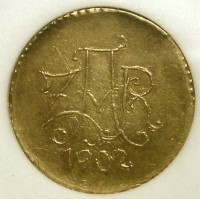
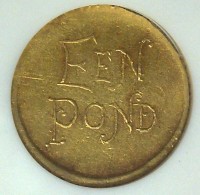
How the Veldpond was made:
The book "From Barter to Barclays" describes (pg 36) in some detail how these unique coins were minted.
The burghers began by making dies carrying the new design - the letters "Z A R" and the date 1902. For in the nature of things it had to be simple. Next these dies had to be cut by minute chisels of toughened steel from metal of softer quality. Although this was successfully done, the next stage of trying to anneal or harden them by plunging them into cold water immediately cracked them. A second, a third and a fourth attempt proved equally unsuccessful. Not until the sixth effort was this obstacle overcome.
Rummaging about the Republicans discovered a machine for hand punching, rather like an old fashioned office letter copying-press. Into this were fitted the dies, underneath which were placed strips of soft gold rolled to the correct thickness. To the delight of the experimenters quite passable impressions were secured.
The next stage was to prepare suitable blank discs. As the improvised coin was inclined to "spread", rather like a pancake squeezed to hard Pienaar*, the Mintmaster, devised an ingenious rim which fitted so well on the blank coin that when the press was brought to bear upon it it even produced a kind of milling round the edges. The result was a very neatly finished coin, the "Veld Pond".
Not that all the troubles had yet been overcome, for much of the gold from the mines (at Pilgrim's Rest) was impure and had to be refined and toughened. It was rolled and re-rolled, annealed and re-annealed, but still the right quality could not be attained. To crown everything the mint ran out of chemicals. Not until that it was discovered that Sublimate of Mercury (used as an antiseptic in the ambulances of the Boers) would do the trick was the hurdle surmounted With no mechanical assistance available, every blank had to be measured out singly. Hundreds were badly struck and melted down afresh, but the result was a success.
*Recent research by Dr Rentia Landman exposes the lie that Kloppers was the mintmaster.
They have always been one of the most sought after and intriguing South African numismatic pieces - £8 to £40 being paid for them not long after the war ended as can be seen from the attached letter.
Striking of the "veldponde" was ironically only completed a few days after the Boers had conceded victory to the British forces.
The assayer of the Veld Pond for the mint making the Veld Pond, M Cooney, wrote to a member of his family "Maggie" discussing the gold coin as can be seen when clicking on the images below. In the letter Cooney says that just 530 coins were struck. The commonly accepted number was nearly double this at 986.
Important validication of the new figure of the mintage of just 530 Veldpond's has now been received from well respected researcher Dr Rentia Landman - her comments cam be seen at this link
QUOTE FROM LETTER SCANNED BELOW: "We had only fairly started to make the crude coins of which enclose is one and all we had made when the British supplanted the Boers in the Transvaal by treaty was 530 coins."! More on Cooney at this link.

Providence David Reed Thomas, Asst. Professor - Doane College:
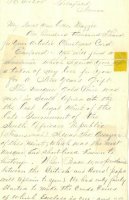 |
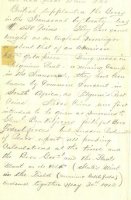 |
Pilgrim's RestA number of insignificant gold deposits were discovered in the northern parts of South Africa between 1840 and 1870. The first gold rush in South Africa took place in 1873 when payable gold was discovered on the farm Geelhoutboom near the town of Sabie on what is now known as the Mpumalanga escarpment. President Burgers, who visited the site, named the camp "Mac Mac" and declared the area the New Caledonia Gold Fields. This discovery saved the Zuid Arrikaansche Republiek from bankruptcy. More on Pilgrims Rest - including images and where the Veld Pond was minted can be seen at this linkOne of the Mac Mac diggers, Alec "Wheelbarrow" Patterson, left the immediate area to prospect further afield. Soon after, he discovered rich gold deposits in Pilgrim's Creek, a tributary of the Blyde River, close to where the village of Pilgrim's Rest now stands. He was able to keep his secret for only a short time before a second prospector, William Trafford, discovered the same deposit of gold. The news of a rich strike triggered the first major gold rush in South Africa. Pilgrim's Rest was declared a gold-field on 22 September 1873. The Gold Commissioner moved his office to Pilgrim's Rest and by the end of 1873 there were some 1,500 diggers working 4,000 claims in and around Pilgrim's Rest. The valley was rich in gold with large finds also being made at Starvation Gully, Peach Tree Creek, Brown's Hill, Poverty Creek, Golden Point and Breakneck Gulley. It is estimated that R2-million worth of gold was mined during the first seven years of mining in the Pilgrim's Rest valley. The scale of this gold-field cannot be compared to those of Australia or California but nevertheless caused much excitement in South Africa. By 1874/75 Pilgrim's Rest had become the social and commercial centre for the diggings then comprising the Upper, Middle and Lower Camps. By 1896 many of the tents had been replaced by more permanent buildings. After the First War of Independence (1880 - 1881) the Republican government instituted a policy of granting concessions to individuals and companies in an effort to stimulate economic and industrial growth. In 1881, David Benjamin, a London financier, obtained the mining rights to Pilgrim's Rest and the surrounding area. His first move was to compensate the remaining diggers for their claims which he then consolidated with the formation of the Transvaal Gold Exploration Company. In 1895, this company, along with other smaller companies, amalgamated to form the Transvaal Gold Mining Estates.
|
The Veld Pond was commonly mounted in 1902/3 and presented to prominent boers soon after the end of the boer war as significant tokens of recognition. Many others were just mounted - the number of Veld Ponds that escaped this is unknown but has certainly reduced their undamaged number to less than half the original mintage.
Mounted or engraved pieces, like with any other coin, can reduce its numismatic value quite considerably.
(Examples of Veld Ponds commonly mounted, ex mount and engraved are displayed below).
|
 |
|
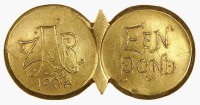 |
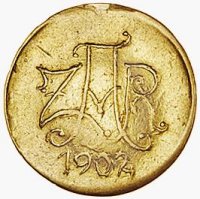 |
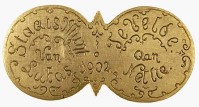 |
Scott Balson's experiences at Pilgrim's Rest
Dr Rentia Landman's research on the Veld Pond
See also the Tabora siege Pound minted in German East Africa in 1916
Value in 2005: The 1902 Veld Pond is highly sought after - valued at over US$20,000 in EF. Never seen on auction.
Pres Burgers)
[1872: Zuid Afrikaansche Republiek (ZAR)
£1 Note] [1874: Coarse Beard Burgers Pond] [1874: ZAR Patterns]
Pres Paul Kruger
[1892 Double Shafted Coins] [1892
- 1900: ZAR Paul Kruger Coins] [OFS Postal
Notes]
[1900 Pretoria Bank Notes] [1901
Pietersburg Bank Notes] [1902 Te Velde Bank
Notes] [Boer POW notes]
[1902: Veld Pond]
[ZAR Coins tampered with by Boer and British Prisoners
of War (POWs)]
Boer War Siege notes and exonumia
[1893 Bechuanaland Border Police
Coins] [1899- 1900: Mafeking Siege Notes and Newspaper
Siege Slips]
[1900 Marshall Hole Bulawayo Card Currency]
Miscellaneous Exonumia
[Who is Paul Kruger]
[Title Deeds signed by Kruger]
[Lord Roberts' proclamation of Kruger's desertion
- Sept 1900]
[Contemporary Books on Boer War]
[Kruger's Unique Family Photo]
[Other Boer Coins & Medallions]
[Zuid Afrikaansche Republiek Coins and Notes]
[Web Site Text Site Map]
[Tokencoins.com Home Page]